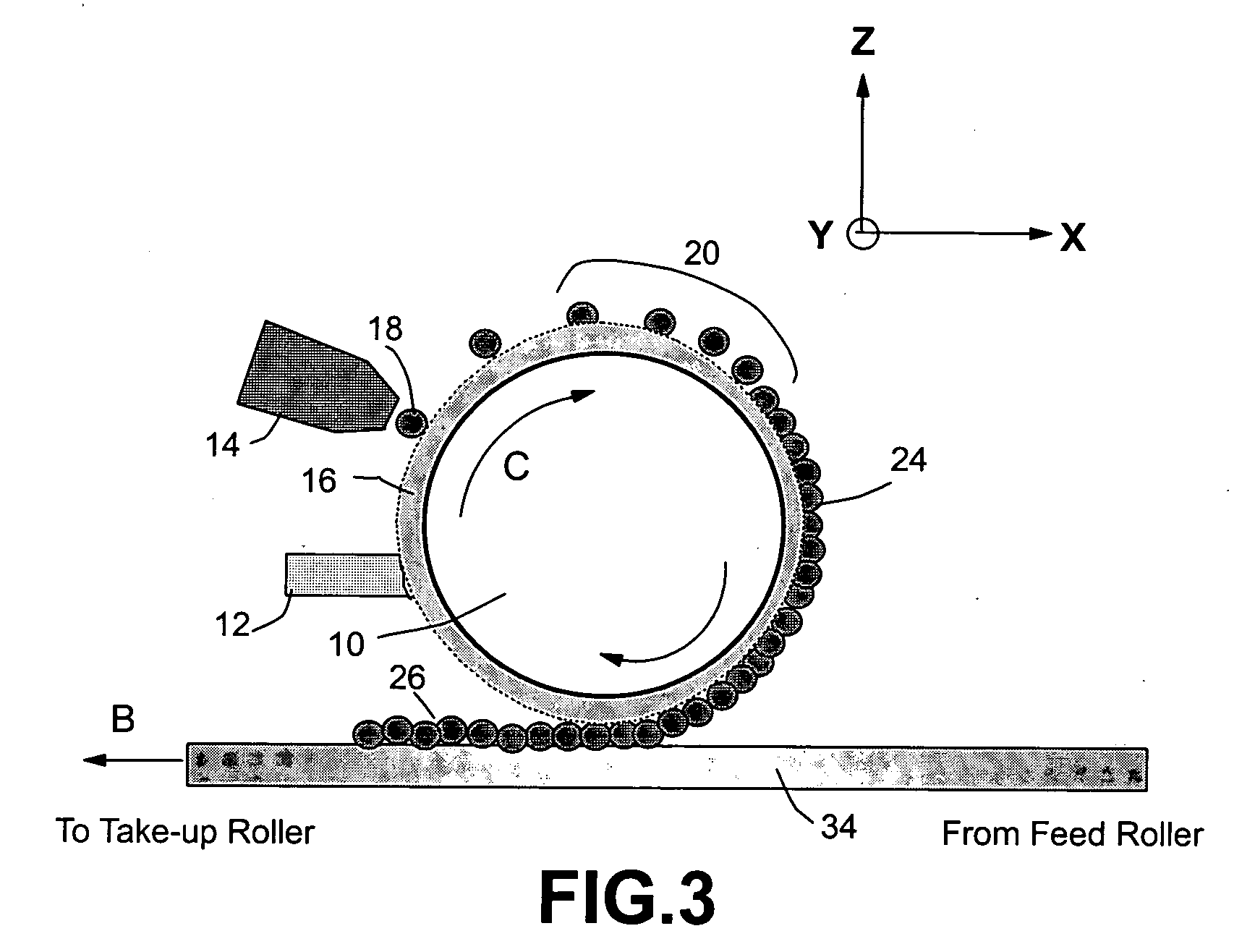Fluid-assisted self-assembly of meso-scale particles
a technology of mesoscale particles and fluidas, which is applied in the direction of solid electrolyte fuel cells, material nanotechnology, coatings, etc., can solve the problems of difficult coating process optimization, limited method, and inability to easily form non-planar and three-dimensional structures using photolithography, so as to achieve the effect of dramatically reducing the amount of platinum catalyst required to operate a pem-based hydrogen fuel cell or a direct methanol fuel cell
- Summary
- Abstract
- Description
- Claims
- Application Information
AI Technical Summary
Benefits of technology
Problems solved by technology
Method used
Image
Examples
examples 1
[0042] One of the examples that we have studied entails preparation of a polystyrene-toluene solution (2% by weight of polystyrene in 98% solvent). When the solution was injected onto the thin liquid film (water) on a rotating drum, polystyrene particles several microns in diameter were precipitated out to the external surface of the film; i.e., at the air-water interface. These particles were then compressed against each other to form a monolayer.
[0043] Hence, another embodiment of the present invention is a method for the preparation of a monolayer of meso-scaled particles, including the steps of (a) injecting a first liquid to form a thin liquid film on an external surface of a rotary member with the first liquid being a non-solvent to a desired solid component; (b) injecting a solution (comprising the solid component dissolved in a liquid solvent) onto the thin liquid film (a non-solvent), thereby causing the solid component to precipitate out in the form of meso-scaled particl...
example 2
[0049] In a laboratory-scale apparatus, a glass cylinder of 6 mm in diameter and 50 mm in length was prepared by polishing its surface with fine abrasives until no scratch line could be seen with an optical microscope at a magnification of 1,000×. A hemi-cylindrical trough was obtained by cutting out and drilling a 10×3.5×0.5 cm PTFE plate. A DC electric motor with a speed control up to 5 Hz was used to drive the glass cylinder. The cylinder was held horizontally by two PTFE circular plates drilled at 2 mm from the center. The gap between the cylinder and the trough could be adjusted to about 300 μm by simply rotating the circular plates. After a vertical position was found, the circular plates were clamped firmly on a rigid plastic structure.
[0050] Spherical polystyrene particles (beads of approximately 1.5 μm in diameter) were dispersed in water containing 0.1% by weight surfactant to form a suspension. The suspension was sprayed line by line across the transverse direction (Y-di...
example 3
[0051] Nanometer-sized ZnO particles were prepared at Nanotek Instruments, Inc. (Fargo, N. Dak.) using a twin-wire arc technique. The particles were dispensed, using an ultrasonic wave based powder feeder, onto a thin liquid (water) film on the external surface of a rotary cylinder, as described in Example 2, but with a second rotary member as shown in FIG. 5. A well-organized monolayer was obtained from these particles that were approximately 50-60 nm in size.
PUM
| Property | Measurement | Unit |
|---|---|---|
| thickness | aaaaa | aaaaa |
| size | aaaaa | aaaaa |
| size | aaaaa | aaaaa |
Abstract
Description
Claims
Application Information
 Login to View More
Login to View More - R&D
- Intellectual Property
- Life Sciences
- Materials
- Tech Scout
- Unparalleled Data Quality
- Higher Quality Content
- 60% Fewer Hallucinations
Browse by: Latest US Patents, China's latest patents, Technical Efficacy Thesaurus, Application Domain, Technology Topic, Popular Technical Reports.
© 2025 PatSnap. All rights reserved.Legal|Privacy policy|Modern Slavery Act Transparency Statement|Sitemap|About US| Contact US: help@patsnap.com



